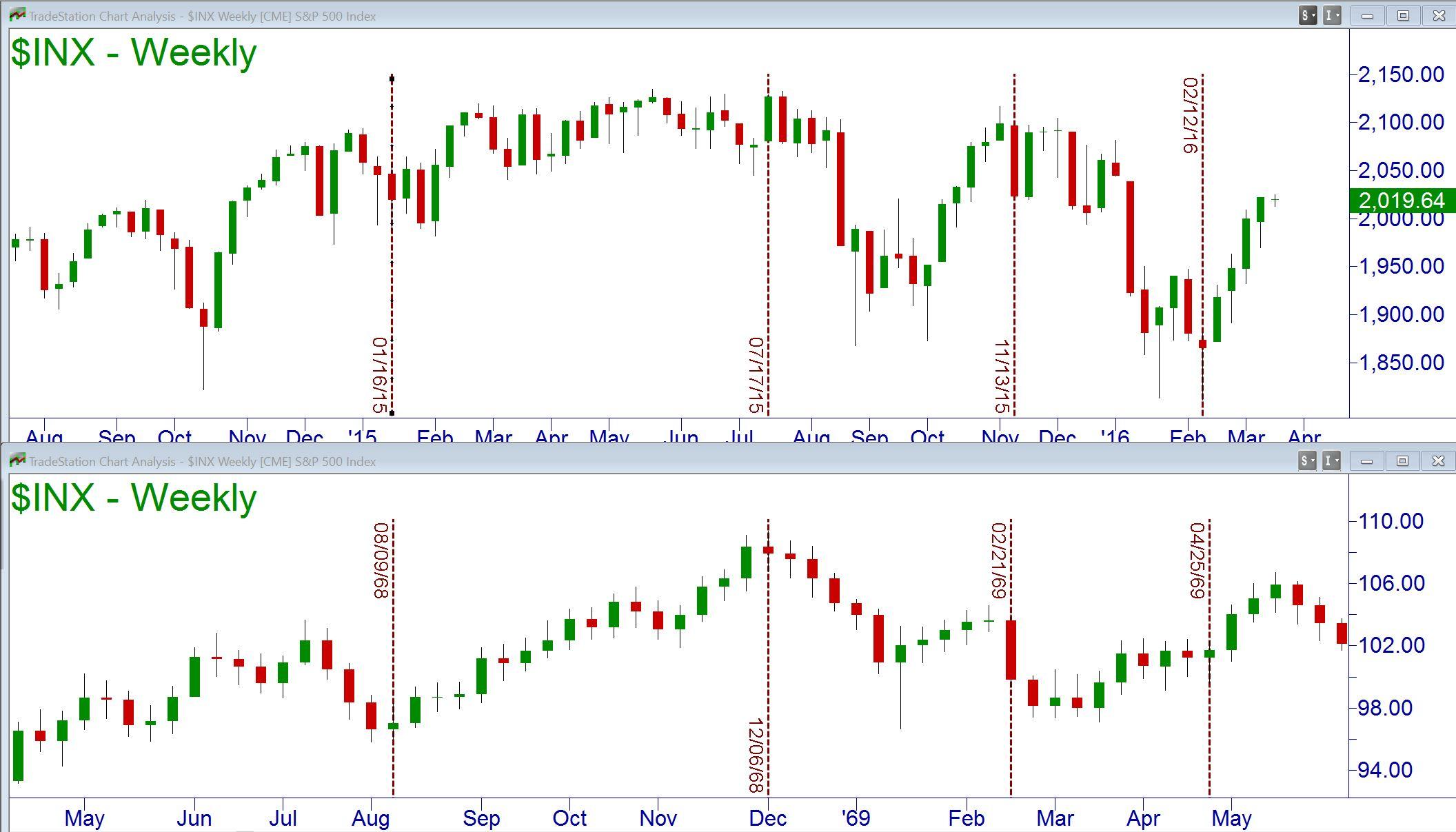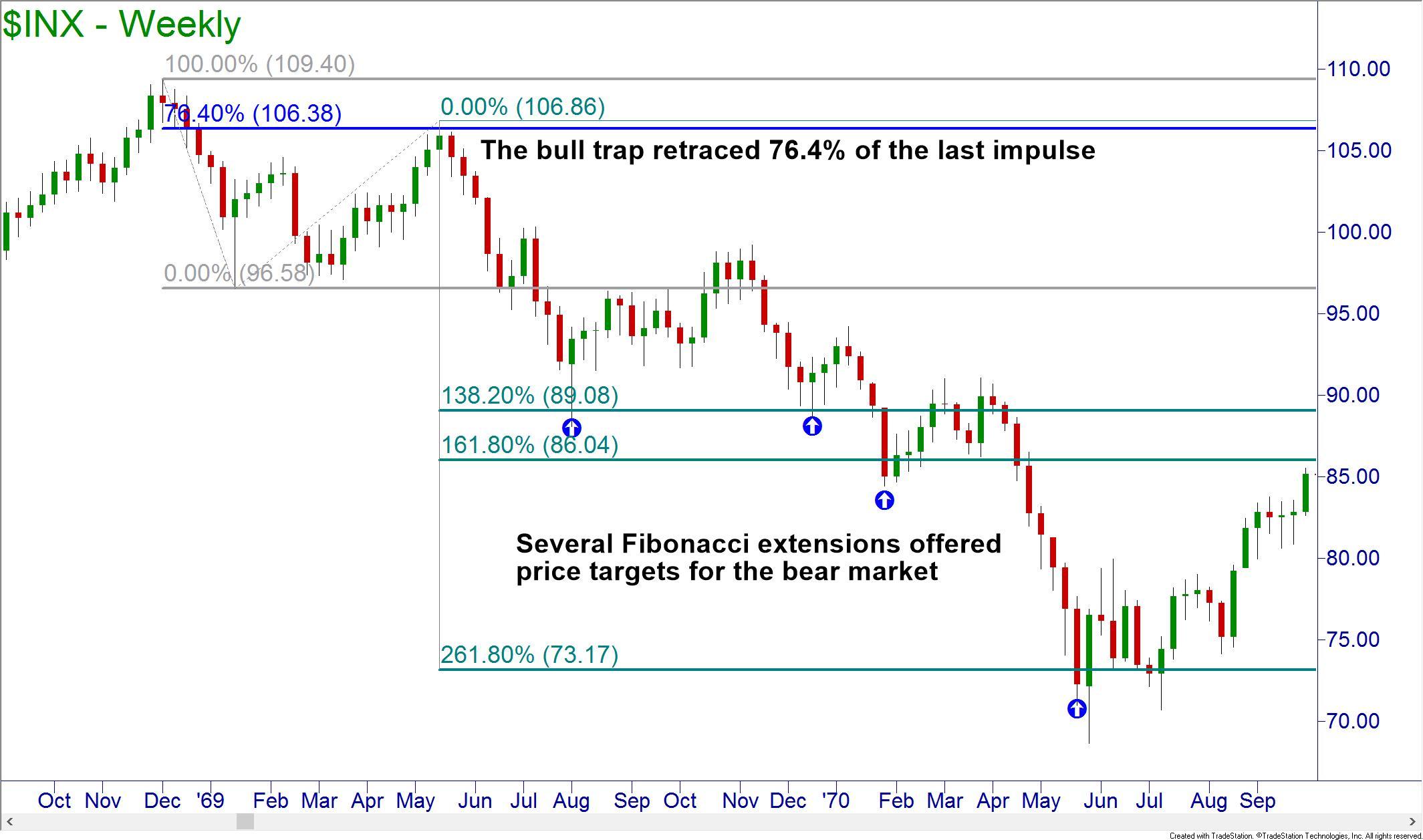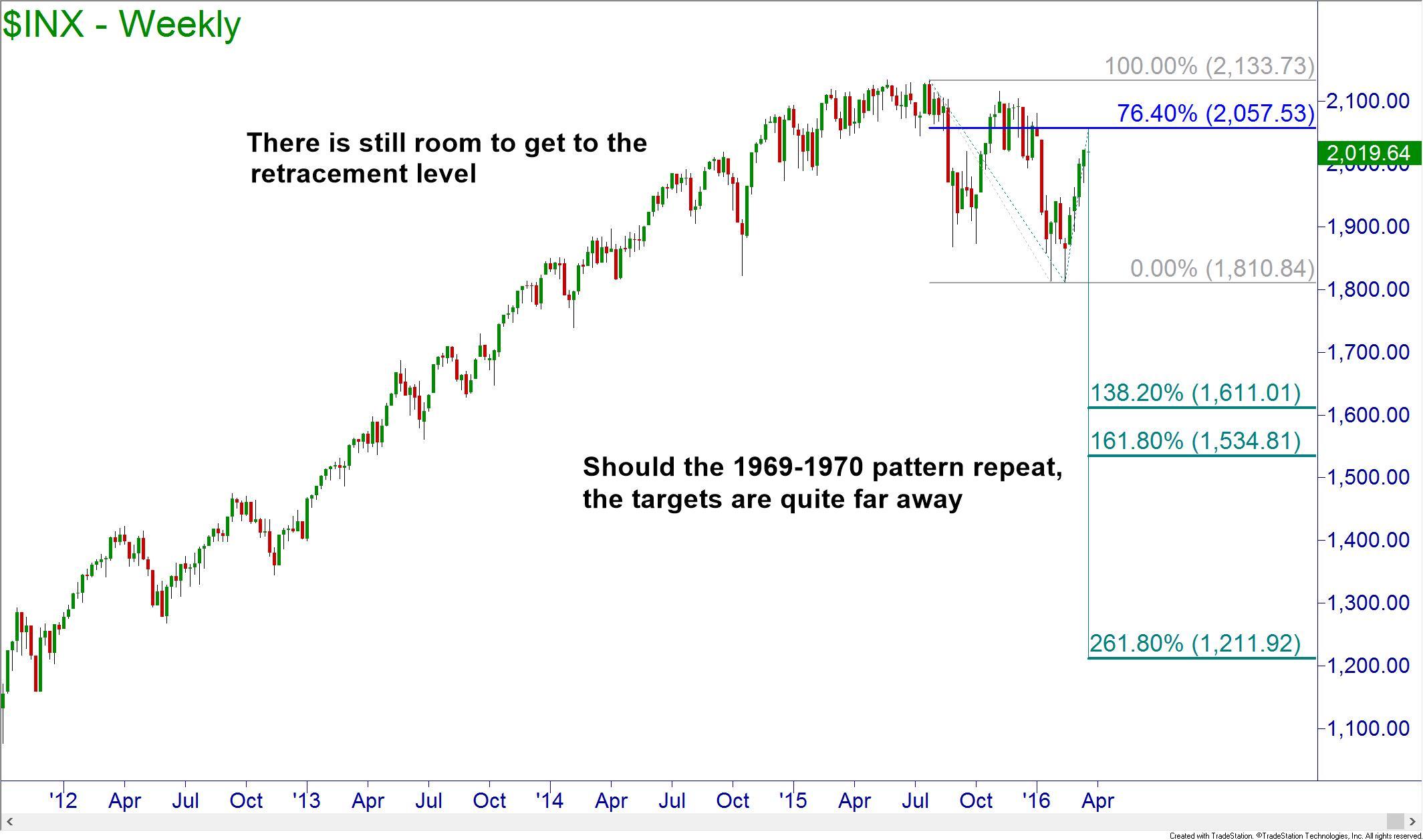George Santayana is popularly known for aphorisms such as, “Those who cannot remember the past are condemned to repeat it.” When it comes to the markets, this is often the rule more than the exception. In fact, Online Trading Academy’s core strategy is based on locating repeatable patterns that demonstrate where the institutional traders are placing their orders.
When you look at charts, you are looking at the historical picture of price action. This price action is caused by the thoughts and perceptions of the market participants. During various economic and political conditions these thoughts and perceptions influence traders and investors in predictable manners. By viewing similar patterns, we can often predict future behavior of the financial markets.
Purely by accident, I was viewing charts of the S&P 500 from the past with one of my classes when I noticed a period of time where the markets looked eerily similar to the price patterns we are currently experiencing. Looking at the following chart, you can see the top chart is a weekly picture of the S&P 500 index. The bottom chart is also a weekly chart of the S&P 500, but from 1968 to 1969.
While not exact, the price patterns are extremely similar. The dips and rallies occurred in nearly the same pattern in 2015 and 2016 as they did in the late 1960’s.
Applying some advanced technical analysis techniques, such as Fibonaccis, to the price action of the 1960s, you can see that there was a bull trap just before the bear market that extended from 1969 through 1970. A bull trap is when prices rise after a sharp decline from a major price peak. This rapid rise leads investors to believe that the drop was only a small correction and that the bull market will shortly resume. This is a pattern that has repeated itself for every bubble burst and bear market.
There was a sharp rise in early 1969 that retraced 76.4% of the drop from the peak in prices. Once the decline began, the Fibonacci Extensions offered potential targets for shorting opportunities, including the bottom of the bear market.
Applying the same Fibonacci techniques to the current S&P 500 price chart, the bull trap appears to be in place and ready to spring on unsuspecting traders and investors. Should we follow the same pattern as the 1960s, the index will continue to climb until approximately 2057. Once there the bear market should begin with prices targeting a few points along the way.
The first major target for bearish price action would be in the low 1600s. Once there, price would likely see a small bounce. The bear market would definitely be in full swing as that would be a price drop from the highs of about 25%. Further price targets are 1530 and the potential bottom of the market at the low 1200s. There is a strong weekly demand at 1440 that could be the bottom instead of the Fibonacci projection.
That brings up an important point. Supply and demand zones are the primary driving force of price. The Fibonacci tools are just to be used as a supporting tool, not the decision maker itself. The retracement to 2057 also corresponds to a supply zone which makes the level stronger. Trust your levels when navigating the markets in order to increase your chances for success.
To learn how to identify the proper zones, visit your local Online Trading Academy Education Center and enroll in a course today!
Neither Freedom Management Partners nor any of its personnel are registered broker-dealers or investment advisers. I will mention that I consider certain securities or positions to be good candidates for the types of strategies we are discussing or illustrating. Because I consider the securities or positions appropriate to the discussion or for illustration purposes does not mean that I am telling you to trade the strategies or securities. Keep in mind that we are not providing you with recommendations or personalized advice about your trading activities. The information we are providing is not tailored to any individual. Any mention of a particular security is not a recommendation to buy, sell, or hold that or any other security or a suggestion that it is suitable for any specific person. Keep in mind that all trading involves a risk of loss, and this will always be the situation, regardless of whether we are discussing strategies that are intended to limit risk. Also, Freedom Management Partners’ personnel are not subject to trading restrictions. I and others at Freedom Management Partners could have a position in a security or initiate a position in a security at any time.
Editors’ Picks
AUD/USD posts gain, yet dive below 0.6500 amid Aussie CPI, ahead of US GDP

The Aussie Dollar finished Wednesday’s session with decent gains of 0.15% against the US Dollar, yet it retreated from weekly highs of 0.6529, which it hit after a hotter-than-expected inflation report. As the Asian session begins, the AUD/USD trades around 0.6495.
USD/JPY finds its highest bids since 1990, approaches 156.00

USD/JPY broke into its highest chart territory since June of 1990 on Wednesday, peaking near 155.40 for the first time in 34 years as the Japanese Yen continues to tumble across the broad FX market.
Gold stays firm amid higher US yields as traders await US GDP data

Gold recovers from recent losses, buoyed by market interest despite a stronger US Dollar and higher US Treasury yields. De-escalation of Middle East tensions contributed to increased market stability, denting the appetite for Gold buying.
Ethereum suffers slight pullback, Hong Kong spot ETH ETFs to begin trading on April 30

Ethereum suffered a brief decline on Wednesday afternoon despite increased accumulation from whales. This follows Ethereum restaking protocol Renzo restaked ETH crashing from its 1:1 peg with ETH and increased activities surrounding spot Ethereum ETFs.
Dow Jones Industrial Average hesitates on Wednesday as markets wait for key US data

The DJIA stumbled on Wednesday, falling from recent highs near 38,550.00 as investors ease off of Tuesday’s risk appetite. The index recovered as US data continues to vex financial markets that remain overwhelmingly focused on rate cuts from the US Fed.
RECOMMENDED LESSONS
Making money in forex is easy if you know how the bankers trade!
Discover how to make money in forex is easy if you know how the bankers trade!
5 Forex News Events You Need To Know
In the fast moving world of currency markets, it is extremely important for new traders to know the list of important forex news...
Top 10 Chart Patterns Every Trader Should Know
Chart patterns are one of the most effective trading tools for a trader. They are pure price-action, and form on the basis of underlying buying and...
7 Ways to Avoid Forex Scams
The forex industry is recently seeing more and more scams. Here are 7 ways to avoid losing your money in such scams: Forex scams are becoming frequent. Michael Greenberg reports on luxurious expenses, including a submarine bought from the money taken from forex traders. Here’s another report of a forex fraud. So, how can we avoid falling in such forex scams?
What Are the 10 Fatal Mistakes Traders Make
Trading is exciting. Trading is hard. Trading is extremely hard. Some say that it takes more than 10,000 hours to master. Others believe that trading is the way to quick riches. They might be both wrong. What is important to know that no matter how experienced you are, mistakes will be part of the trading process.




